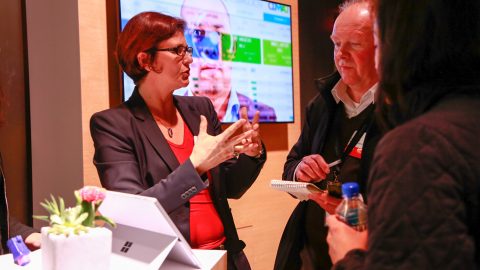
Time is of the essence for companies seeking a digital difference
Every day is precious inside the digital revolution as companies race to evolve ahead of industry disruption – and simultaneously reap a bounty of newfound time savings.
At Digital Difference, a recent Microsoft event in New York, more than a dozen companies displayed the latest efficiencies they are unlocking in their own data, including quicker deliveries, streamlined designs and swifter decisions.
“Human invention continually revolutionizes how companies can better serve their customers, create entirely new products and markets, overhaul operations or empower their workforce,” said Judson Althoff, Microsoft’s executive vice president for worldwide commercial business. “Digital transformation is more than industry buzz. It is not a question of if, but when.”

Case in point: Trimble, a global architecture firm that has launched the SketchUp Viewer for Microsoft HoloLens, which allows customers to inhabit and inspect mixed-reality versions of construction projects, reducing design iterations and saving time.
Also at Digital Difference, transport giant Maersk revealed that it is betting on Microsoft to reshape the global supply chain industry, including providing real-time shipping information to customers. And Bank of America Merrill Lynch demonstrated how it’s streamlining trade finance via blockchain, an emerging way for businesses, industries and public organizations to make and verify transactions nearly instantaneously.
One clear trend is emerging among these companies: They are finding fresh efficiencies on the clock. Because, after all, time is money.
Over the next few months, the Transform blog will feature several storylines inspired by companies now making a digital difference. Some organizations are revamping the customer experience, particularly in grocery stores. Others are offering a new reality of design or a new vision of fan engagement in sports. Still more are modernizing the supply chain.

“I’ve never seen a more dynamic time,” said Abbie Lundberg, a business technology analyst and author who spoke on a panel at the Digital Difference event. “The change is happening quickly.”
Here’s how fast: Among nearly 800 digital leaders recently surveyed around the world, a majority said that their industries have passed the inflection point of disruption – or will pass that mark by 2020, according to a new report by Harvard Business Review (HBR) Analytic Services and Microsoft. Lundberg authored the report.
Other findings from that survey:
- Nearly half of respondents (47 percent) believe their current business model will be obsolete within three years.
- More than half (57 percent) said their company has now shifted funding, people and other resources away from legacy lines of business to support new digital business models.
- The vast majority (86 percent) consider disruption to be an opportunity rather than a threat.
“A lot of these technologies have been around for a long time,” Lundberg said in a recent Q&A. “Artificial intelligence is not new. Sensors are not new. But with the cloud and with the increasingly lower cost of computing, the ability to bring together all of these capabilities is just making things possible that were never possible before.”
Visit the Transform blog June 5 for the first story in our Digital Difference series, about the transformation of the customer experience, perhaps underway now at your local grocery store.
Top image: Andrew Ostrovsky/Getty Images. Event photos by Brian Smale.







